#Cleopatra the alchemist
Explore tagged Tumblr posts
Text

Cleopatra the Alchemist (Greek: Κλεοπάτρα; fl. c. 3rd century AD) was a Greek alchemist, writer, and philosopher. She experimented with practical alchemy but is also credited as one of the four female alchemists who could produce the philosopher's stone. Some writers consider her to be the inventor of the alembic, a distillation apparatus. She appears to have been active in Alexandria in the 3rd century or 4th century A.D. She is associated with the school of alchemy typified by Mary the Jewess and Comarius. These alchemists used complex apparatus for distillation and sublimation.
Art by Sato Futaba author of the historical mangas "Utae, Erinna!" and "Anna Komnene"
#ancient rome#roman egypt#alchemy#ancient alchemist#women alchemist#women scientists#women's history#women in history#women at work#Cleopatra#Cleopatra the alchemist#historical person#historical art#manga#Sato Futaba
9 notes
·
View notes
Text


Your fantasy 🌊🌺💋

︶⊹︶︶୨୧︶︶⊹︶✦ . ⁺ . ✦ . ⁺ . ✦ ୧‿̩͙ ˖︵ ꕀ⠀ ♱⠀ ꕀ ︵˖ ‿̩͙୨
8 notes
·
View notes
Text
Not every lady is a warrior, and that's okay
Snow White isn't a warrior - she is a lady diplomat, and later ruler And that's okay
Cinderella isn't a warrior - she is a lady, artist, and later ruler, and that's okay
Aurora isn't a warrior - she is a lady, diplomat and later ruler. And that's okay
Jane Bennet isn't a warrior - she is a lady and artist. And that's okay
Meg March isn't a warrior - she is a homemaker, artist and lady. And that's okay
Hurrem Sultan isn't a warrior - she is a lady, diplomat, ruler and strategist. And that's okay
Lucrezia Borgia isn't a warrior - she is a lady, cultural patron and diplomat. And that's okay
Maid Marian isn't a warrior - she is a lady, cultural patron and diplomat. And that's okay
Cleopatra VII isn't really a warrior - she is a lady, alchemist and ruler. And that's okay
Scheherazade isn't really a warrior - she is a lady, storyteller, ruler and diplomat. And that's okay
Laura Vlahos ( Clint Barton's wife ) isn't a warrior - she is a medic. And that's okay
Cosette isn't a warrior - she is a lady and artist. And that's okay
Queen Guinevere isn't really a warrior - she is a lady, strategist, cultural patron and ruler. And that's okay
Millie ( 7 Brides ) isn't a warrior - she is a homemaker and agriculturalist. And that's okay.
Christine Daae isn't a warrior - she is a performing artist and lady. And that's okay
Duchess ( Aristocats ) isn't a warrior - she is a lady, socialite and musician. And that's okay
Lady Jocelyn ( A Knight's Tale ) isn't a warrior - she is a lady and diplomat. And that's okay
Padme Amidala isn't really a warrior - she is a lady, ruler, diplomat and politician. And that's okay.
A lady can be impressive even without swinging a weapon
#a lady can be impressive without swinging a weapon#not everyone is a warrior AND THATS OKAY#cleopatra vii#hurrem sultan#christine daae#cosette#jane bennet#meg march#snow white#cinderella#aurora#maid marian#silk hiding steel#scheherazade#queen guinevere#lady jocelyn#a knights tale#padme amidala#star wars#poto#les mis
233 notes
·
View notes
Text
Alchemy ID Pack
Pt: Alchemy ID Pack /end pt



Pfp mask by me // Image
Names: Alchemy, Apollo, Artephius, Aur, Aurora, Aurum, Basil, Cleopatra, Copper, Crocus, Curtis, Gold, Goldie, Goldy, Helio, Iron, Issac, Izumi Lead, Mercury, Nemean, Newton, Rosaura, Savanna, Silver, Sovanna, Tin
Pronouns: al/alchemy, alchemy/alchemys, char/charcoal, charcoal/charcoals, chem/chemicals, chemical/chemicals, copper/coppers, gold/golds, heraldic/heraldics, iron/irons, lead/leads, mercury/mercurys, silver/silvers, tin/tins, toxic/toxics, transform/transforms, ⚗️/⚗️s, 🪙/🪙s
Titles: prn who studies / preforms alchemy, prn who transforms metal to gold, prn who works with metals, the alchemist, the chemist, the sorcerer, the witch, prn who is a sorcerer, prn who loves gold, prn that studies the elements / metal
Genders: Alchimagiworldgender, Alchemapprentia, Genderalchemist, Y/nalchemist, Alchemist System, Royalchemic, Prialchemic, Alchemicesse, Aur, Aren, Aeris, Fera, Lan, Mera, Sana, the Alloy Alignment System in general
Other ids: Alchemist Occuden, Interdimensional Chemist Occuden, Invigoldpile,
Text in bold is Names, Pronouns, Titles, Genders, and Other ids rrespectively
Requested by Anon
Tagging @id-pack-archive
#alchemist id pack#npts#npt suggestions#npt set#npt list#npt ideas#id pack#name pack#name ideas#name suggestions#pronouns#pronoun list#asks#pronoun ideas#i didnt have many ideas for this sorry-
9 notes
·
View notes
Text
sporeling oc :)
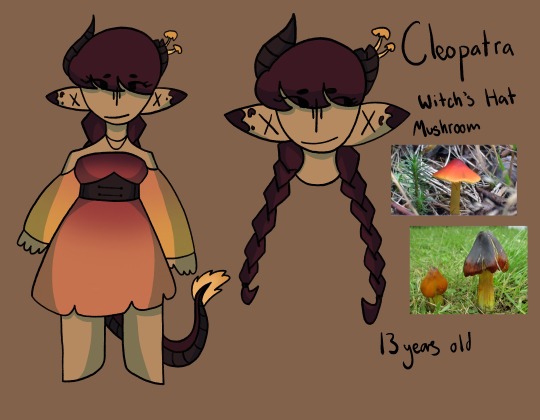
this is cleopatra (she/her)! her backstory is that she was a dragon hybrid (specifically the wingless east asian inspired variant so she didn’t have wings to begin with) who was on a ship that got taken over by a storm. she washed up half dead at the shores of the mushroom island, and mother spore saved her and took her in!
because she was originally a dragon hybrid she still has some magic (weaker fire magic) and she is also a very talented alchemist!
she’s pretty nice and definitely the “mother” of the group, but also won’t hesitate to go batshit and is very sarcastic at times
she likes annoying HEP, having tea with mother, and particularly bugging the mayor.
she also may or may not have an unattainable crush on false (which definitely gets in the way of annoying HEP sometimes)
anywho sporelings au is by @sporelings-au (i also just realized that my username fits really well with this lmao)
50 notes
·
View notes
Text
“The work of many gifted women known to history by name is a salutary reminder that, as the majority of the human race, women have always commanded over half of the sum total of human intelligence and creativity. From the poet Sappho, who in the sixth century B.C. was the first to use the lyric to write subjectively and explore the range of female experience, to the Chinese polymath Pan Chao (Ban Zhao), who flourished around A.D. 100 as historian, poet, astronomer, mathematician and educationalist, the range is startling. In every field, women too numerous to list were involved in developing knowledge, and contributing to the welfare of their societies as they did so: the Roman Fabiola established a hospital where she worked both as nurse and doctor, becoming the first known woman surgeon before she died in A.D. 399.37 In various fields, too, women emerged not simply as respected authorities, but as the founding mothers of later tradition: Cleopatra, "the alchemist of Alexandria," an early chemist and scholar, was the author of a classic text Chrysopeia (Gold-making), which was still in use in Europe in the Middle Ages, while the Chinese artist Wei Fu-Jen, working like Cleopatra in the third century A.D., is still honored today as China's greatest calligrapher and founder of the whol school of the art of writing.”
-Rosalind Miles; Who Cooked The Last Supper?; The Women’s History of the World
#who cooked the last supper#herstory#patriarchy#radblr#radfem#radical feminism#radical feminist safe#radical feminists do interact#radical feminists do touch#radical feminists please touch#feminism#feminist literature#radical feminists please interact#radical feminist community#radical feminist literature#radical feminst#radical feminist theory#womens history
20 notes
·
View notes
Text
Women in Alchemy
Like many aspects of history, woman have been widely removed from the narrative of alchemy’s history. However, this false narrative hides the extraordinary impact that female figures had in the world of alchemical practices.
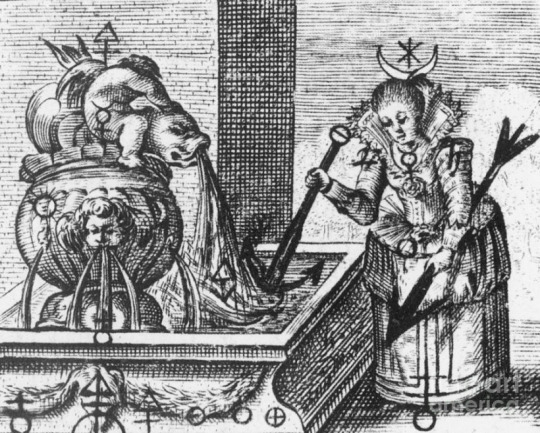
Michael Maier (German physician and counsellor to Rudolf II Habsburg, a notable alchemist) named women who were able to create the famed Philosopher’s Stone.
Mary the Jewess
A.k.a. Mary the Prophetess or Maria the Copt; Mary the Jewess was an early alchemist who became known from the works of Zosimos of Panopolis (Greco-Egyptian alchemist). On the basis of this work, Mary the Jewess lived between the first and third centuries A.D. in Alexandria. She is noted as one of the first alchemical writers, with her works not being dated later than the first century.
Mary is credited with the invention of multiple kinds of chemical apparatus, and is considered the first true alchemist of the Western world. She believed that metals had two different genders, and that if you were to join these two together a new entity could be made.
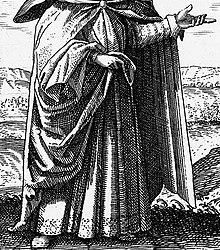
Axiom of Maria
One becomes two, two becomes three, and out of the third comes one as the fourth
Carl Jung notably used this axiom as a metaphor for individuation, and wholeness.
Inventions
Tribikos
An alchemical still (alembic) with three arms used to obtain substances purified by distillation
Still used today in chemistry labs
Kerotakis
Device used to heat substances used in alchemy, as well to collect vapors
Bain-marie
A.k.a. “Mary’s bath”
Limits the maximum temperature of a container and its contents to the boiling point of a separate liquid (essentially, it is a double boiler)
Cleopatra the Alchemist
A Greek alchemist and philosopher active in Alexandria during the 3rd or 4th century A.D. It’s notable that this is not Cleopatra VII, rather this is a pseudonym for an unknown author (or even a group of authors). Despite her hidden identity, Cleopatra the Alchemist is a foundational figure in alchemy, her influence perhaps even pre-dating Zosimos of Panopolis.
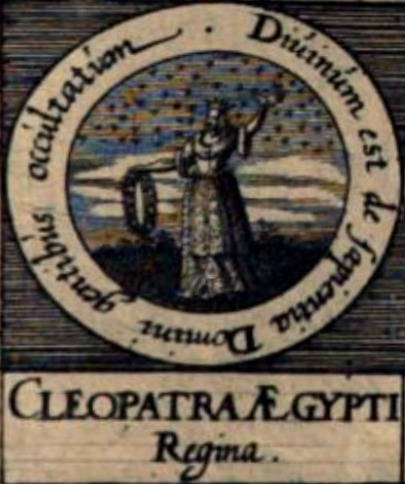
Cleopatra the Alchemist is most noted for the Chrusopoeia of Cleopatra, a lone sheet document containing only symbols, drawings and captions. Examples of the imagery seen are the Ouroboros, an inscription saying:
One is the Serpent which has its poison according to two compositions, and One is All and through it is All, and by it is All, and if you have not All, All is nothing.
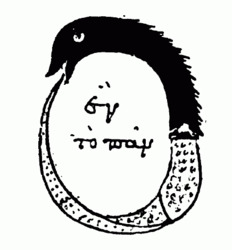
There are also drawings of “dibikos”, an instrument similar to a kerotakis.
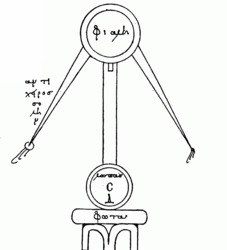
Another is a symbol of the eight-banded star, and many believe the drawing of these star symbols and the crescent shapes above them are a depiction of turning lead into silver.
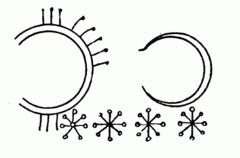
Paphnutia the Virgin
Living around the time of 300 C.E., Paphnutia was an Egyptian alchemist referred to in the letters between Zosimos of Panopolis and his sister, Theosebeia (also assumed to be an alchemist). Within these letters, Zosimos criticizes his sister for associating with Paphnutia, someone he considered to be uneducated and incorrect in her practice of alchemy.
Little else is known about her, aside from the possibility that she could have also been a priestess. It’s also theorized that she was connected to a school of alchemy that competed with that of Zosimos.
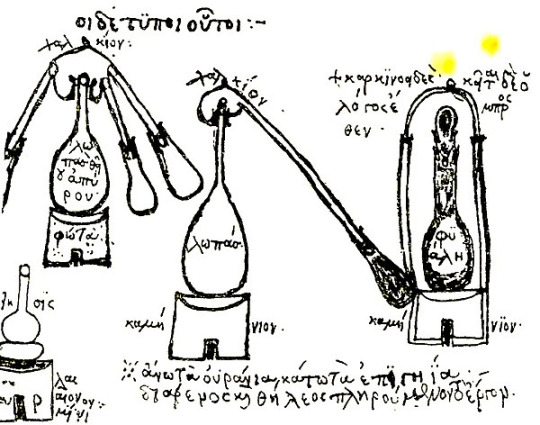
44 notes
·
View notes
Text

So! The Chrysopoeia of Victoria Harvey is a comic that I already started in Portuguese (if you want to see its prologue, it's here) about those small adorable pests above: from left to right, Victor "Vic" Harvey, Cristóvão "Chris" de Sá, Zico Fernandes, Natalie Smith and Anne Louise Saint Anne, as they go to magic school and grow up, come of age, stumble on mysteries about the school founders, fangirl over old-timey swashbuckling comic characters and navigate the complicated word that will lead to their world's version of the Second World War.
The plot is mostly centered on Vic, hence why it's her on the title.
"But Adriana, the title says 'Victoria' and your character lineup says 'Victor'."
Well, the title of the comic is a play on the artifact known as "the chrysopoeia of Cleopatra", a manuscript with a single page detailing Cleopatra's (the alchemist, not the queen) recipe for producing gold ('chrysopoeia' means 'the making of gold'). Vic lives in the aptly named Alchemy Village and the whole comic is structured around the making of the Philosopher's Stone (the first step of a classic chrysopoeia). I'll tell more about it as I publish the episodes.
I'll let you guys decide why I'm giving the comic a title about a multi-step complex process of turning things into better things and, eventually, into the bestest thing possible.
This is what I've been mostly doodling about, so now you guys know enough to not be TOO out of depth.

Welcome to De Garoustés School of Magic Fundamentals. It'll be fine. Probably. Eventually.
#comic#a crisopeia de victoria harvey#alchemy#lgbtqia#in case you DIDN'T catch my drift about Vic's name change#30's in a magic world#magic school#OMG I have SO DANG MUCH to talk about this comic GOSH#why yes you HAVE seen those symbols before#today even#vic's chrysopoeia#chrysopoeia
2 notes
·
View notes
Text
Guess whooose back on their alchemy bullshit again with 17 tabs open in google about alchemy
Such as how it is believed that the ourobourous in alchemy is a symbol for gold making because of the word chrysopoeia being written next to a symbol of an ourobourous in a manuscript written by Cleopatra the alchemist (not the Egyptian Queen someone different) the manuscript being known as Chrysopoeia of Cleopatra
She is also 1 of 4 female alchemist who is believed to have produce a philosophers stone
With chrysopoeia meaning artificial gold making
11 notes
·
View notes
Text
Notes on Symbology: Mercury, Life And Death
Mercury is an element that has long fascinated me, particularly due to it’s metaphysical significance and what it represents. This element has captivated alchemists from ancient Egypt to medieval Europe. Mercury was the prima materia- the progenitor of all other metals. Referred to as quicksilver, it was used for transmutation and became a crucial element in the science of practical alchemy. Mercury is represented by the astrological symbol for the Roman god of the same name.
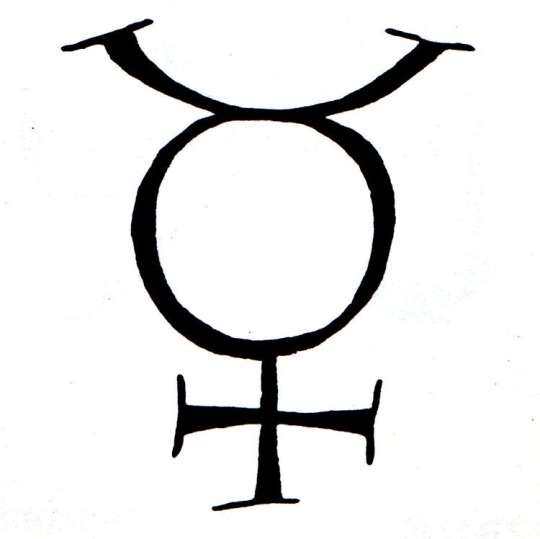
Alchemical symbol for Mercury.
For me, the element of mercury is a Wodenic symbol. The symbol itself depicts the horned god. Archaeological findings often portray Woden with two horns protruding from his head. These horns may signify Woden’s ravens, Hugin and Munin, who represent memory and thought. In spiritual alchemy, mercury has long been associated with the spirit and mental capabilities including intelligence, wisdom, memory, and creativity. Amongst the Romans, Mercury has been depicted donning a winged helmet. Mercury journeyed throughout the many realms, especially the underworld. The element could easily transform into a liquid or solid. To the ancient alchemists, this represented life and death. Additionally, mercury corresponds to the lungs. Mercury signifies the breath of life, which Woden gifted to the first man and woman, Askr and Embla.

Anglo-Saxon Woden pendent, 6th century AD.
In alchemical manuscripts, snakes are symbolic of mercury. A particularly notable symbol of the Roman god Mercury is the caduceus, a staff with two snakes wrapped around it. Furthermore, the caduceus is present in the alchemical symbol of mercury. Cleopatra the Alchemist illustrated an ourboros to represent the philosopher’s stone. The ourboros represents the never ending cycle of life, death, and rebirth. In Germanic mythology, the midgard serpent, Jormungandr, is wrapped around the world biting it’s tail.
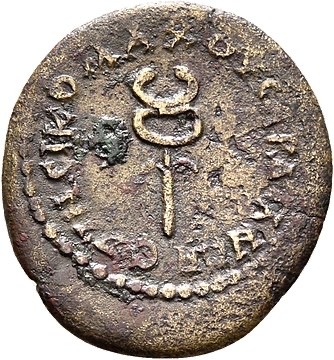
Coin featuring the caduceus, Turkey, 1st century AD.

Cleopatra the Alchemist’s ourboros, 3rd century AD.
So, in general, what does mercury represent? Mercury is the journey of life and death. It is creation, our origin point, the very beginning. I connect mercury to the ginnungagap, the void that existed before the cosmos. The void exists between the realm of fire and the realm of ice, reminding me of the cold and hot extraction methods used to produce mercury from cinnabar. Mercury is the unification of opposites- life and death, hot and cold, liquid and solid. Moreover, it is the power of one’s mind. The thirst for knowledge, deep contemplation, and generative creativity are all found within mercury. The element is the beginning, the end, and the voyage in between. It is our first breath and the final breath that escapes us. It is the horned god, the allfather, divine wisdom.

Ulrich Ruosch Manuscript, Switzerland, 1680.
15 notes
·
View notes
Note
Who is in the bracket. I need to project on to my blorbos.
here's a list of everyone who will be in the bracket, NOT in order because i lost my bracket and have to remake it, but these are all the players im putting out on the field
Klavier Gavin (Ace Attorney)
Tachibana Hinata (Fabiniku)
Loid Forger/Twilight (Spy x Family)
Juno Steel (The Penumbra Podcast)
Iruma (Mairimashita! Iruma-kun)
Kashima Yuu (Gekkan Shoujo Nozaki Kun)
Magnus Bane (Shadowhunters TV 2016)
Viola/Cesario (Twelfth Night)
Rem (Death Note)
Double Trouble (She-Ra and the Princesses of Power)
Garnet (Steven Universe)
Godot (Ace Attorney)
Alex Fierro (Magnus Chase and the Gods of Asgard)
Fiona (Shrek)
Adrien Agreste (Miraculous Ladybug)
Howl Jenkins Pendragon (Howl's Moving Castle)
Fujimoto (Ponyo)
Aziraphale and Crowley (Good Omens)
Jonathan Sims (The Magnus Archive)
Francois (Dr. Stone)
Kirby (Nintendo)
Nanamine Sakura (Toilet Bound Hanako Kun)
Luna (Vanitas no Carte)
Kenjaku (Jujutsu Kaisen)
Jessie and James (Pokemon)
Loki (Norse Mythology)
Luz Noceda (The Owl House)
Neo Metal Sonic (Sonic)
Khensu (Cleopatra in Space)
Vinnie Dakota (Milo Murphy's Law)
Avery (Pokemon Shield)
Mikitaka (JoJo's Bizarre Adventure)
Bugs Bunny (Warner Bros)
Maxwell Klinger (M*A*S*H)
Whisper (Yokai Watch)
Batsubami Rei (Kakegurui)
Yuka Ayukawa (Blue Period)
Stacey (Kikai Sentai Zenkaiger)
Mizuki Akiyama (Project Sekai)
Deidara (Naruto)
Scarecrow (The Wizard of Oz)
Chris (Thomas Was Alone)
Testament (Guilty Gear)
Envy (Fullmetal Alchemist)
Kuranosuke Koibuchi (Princess Jellyfish)
Link (Legend of Zelda)
Yoo Joonghyuk (Omniscient Reader's Viewpoint)
Aoi Kureha (Paradox Live)
Mae Borowski (Night in the Woods)
Phosphophyllite (Houseki no Kuni)
Kyza (Fire Emblem: Radiant Dawn)
Idia Shroud (Twisted Wonderland)
Lake (Infinity Train)
Winston Bishop (New Girl)
Mr. Finch (Person of Interest)
Nightshade (Transformers: Earthspark)
Callum (Subway Surfers)
Haruhi Fujioka (Ouran High School Host Club)
Haruka Tenou (Sailor Moon)
HiMERU (Ensemble Stars)
Wataru Hibiki (Ensemble Stars)
The Toy Soldier (The Mechanisms)
Kris, Frisk, and Chara (Undertale/Deltarune)
Teruki Hanazawa (Mob Psycho 100)
again these are NOT IN ORDER! the actual bracket should be out ugh. whenever i have time to remake it. if u have any complaints abt any of the characters pls tell me bc i probably wont do anything about it but i love drama
25 notes
·
View notes
Photo











GudaGuda Style Practice
I wanted to practice my line quality and drawing in the GudaGuda style so I drew a bunch of different Fate ocs in the GudaGuda style. This was my first time doing this and it was very experimental so I apologize if anybody’s characters look wonky. I definitely would have done some differently in hindsight.The characters in order of appearance and with each creator’s Twitter @’s are-
@Omegazplayer- Amelia https://docs.google.com/.../1bQDTIGhLzoVu2e9uMWn2Za9.../edit
@mochio_bonio- Hang Tuah https://docs.google.com/.../12mjNkmjnhIIeLgGRvSlVVLh.../edit
@corvusium- b̶n̶y̶ Krypton https://toyhou.se/15126317.master-krypton
@alioathereal- Ana https://twitter.com/alioath.../status/1632601560579465216...
@yuki_setsura- Anita https://docs.google.com/.../1_Sy20u2ofNnUYo6NLssMH1X.../edit
Shout out to Setsu’s hijab tutorial: https://twitter.com/yuki.../status/1634435595194998784...
@IketheNinja14- Cleopatra(The Alchemist not the pharoh) https://docs.google.com/.../1Cr69DeCq49w5h1UshoUwmsM.../edit
Me- Shaka Zulu https://docs.google.com/.../1F1eWTJZItB1gibCdiDrRFYr.../edit
Me- Yasuke https://docs.google.com/.../1M7V-XS0S_hePGtpLHY3abI.../edit
@Gibger28- Tlahuicole https://twitter.com/Gibger28/status/1240531943290093569
8 notes
·
View notes
Text
I should have been in bed nearly two hours ago, but this thing is haunting me.
I'm going to repeat some points I've already posted, but some things bear repeating.
That was the worst series finale I have ever seen. I thought the finale of Preacher was an ugly little fiasco. My word. It will be hard to top this one! Holy frickle-dickles.
(The X-Files, Supernatural, Fullmetal Alchemist... I'm used to pain, but this tempted me to break out the Jack Daniels).
So, yeah. Ding-dong, the cunt bag... -s are all dead? What was the fucking point of that? EZ, completely expected, especially when it was said, 'We've all been talking'. It was a bit of a push for the poetic, that EZ would pull a Mark Antony quote, then get Julius Caesared. (I feel like I made a comment about that last season, but it might have been a verbal conversation). Anywho. I just don't understand the point of the rest. (After a few hours of sleep, I might be able to gather what they were going for, but we shall see). Taking out Bottles, of all people...
I see some fix-it fics in my future. Some out of spite.
I liked Potter in Sons. I did. He was responsible for his share of shit, but his character was well-written. They ruined him in Mayans, so hard. He's come across half-crazed, and tipping off his axis. I'm so disgusted that he's still walking around, King of the Fucking Hill. If ANYONE needed to catch a bullet - aside from EZ - it was old Pot-Ash.
*ahems*
I'm actually really mad that Emily got her way, too. Not just because of Miguel, but because of the utterly simplistic way it went down. (Let's face it, that wasn't a terribly inventive plot she cooked up). Killing Miguel was just the quick way to tie up another useless loose end, leaving the Gallindo family no different than the rest of the story.
Fucking. Pointless.
List of Other Pointless Things Bugging Me:
* Letty's rage. Don't get me wrong, I'm over the damned moon that she and Sally are in the clear. But, that Letty found Sally, and the bloody trailer, and just... abandoned everything? C'mon.
* Bringing Taza back. Again, y'all know I was ELATED to see the bastard, but not to get him on-screen again?? I find solace in the fact that I didn't have to watch him die.
* Angel spotting the pictures and letters in Miguel's hand during Felipe's funeral. I had hope, and it went NOWHERE. As expected. As usual.
* Sofia's pregnancy, and death. I assume the pregnancy was to make her pointless death more tragic, but it was still a waste of time. (Bitch is no Cleopatra). If EZ had found out? Yeah, maybe. I know the broad was a loose end, too. No question. Had to eradicate (nearly) all that was EZ's. It was just the same writing as the rest of the season:
Sloppy, and lazy.
* The war. That wasn't a war. That was a bunch of kids taking turns beating each other up on their way home from school.
* The pipeline. There was no fixing that shit, and we spent the bulk of the FINAL MOTHERFUCKING SEASON on it.
There's more, but my brain aches for rest.
A Couple of Things I Enjoyed:
* Marcus getting the chance to be a good father. It was nice, given his relationship with Jax Teller. He saw a father lose it all, and now he's getting to have it all. Bonus Dad Points for doing the skin-to-skin contact with the baby. That was just beautiful. ❤️.
- It was also a reminder to keep at the birth control. 🤣. When Marcus started talking about not getting to see his son's children, I got to thinking about how the guy I'm seeing is two-and-a-half decades older than me, and... Yeah. Math, indeed. You didn't need to know that, but there it is!
* That was a nice chat on the bridge. It was. Brought me back to my own childhood, and moments where I had to stay strong to protect my own brother. Solid, believable stuff, right there.
Dude. Was that really all that I enjoyed?
Fuck the J.D. It's time for the Jose Cuervo.
Catch y'all on the fic side.
-Mycki
6 notes
·
View notes
Text
You know, now I kinda want to make a list of every individually identified character in Hell. Circle by circle, counting only human damned souls (* marks people that are said to be destined for that circle):
Antinferno, the neutrals Unnamed figure traditionally identified with Pope Celestine V (Italian)
Circle I or Limbo, the virtuous pagans Ooh boy. Virgil, Horace, Ovid, Lucan, Julius Caesar, Lucius Brutus, Lucretia, Julia, Martia, Cornelia, Cicero, Linus(ancient Romans, I guess you could consider them Italians) Camilla, Latinus, Lavinia (pre-Roman Italians) Homer, Electra, Aristoteles, Socrates, Plato, Democritus, Diogenes, Anaxagoras, Thales, Empedocles, Heraclitus, Zeno, Dioscorides, Orpheus, Euclid, Ptolemy, Hippocrates, Galen (Greeks) Hector, Aeneas, Penthesilea (Trojans) Saladin (Kurdish) Seneca (Hispanic) Avicenna (Persian) Averroes (Arab)
Circle II, the lustful Semiramis (Babylonian) Dido (Carthaginian) Cleopatras, Helen, Achilles (Greek) Paris (Trojan) Tristan (Cornish) Paolo Malatesta, Francesca da Rimini (Italian)
Circle III, the gluttonous "Ciacco" ("hog") (Italian)
Circle IV, the greedy and the spendthrifts (none named)
Circle V, the wrathful and the slothful Filippo Argenti (Italian)
Circle VI, the heretics Farinata degli Uberti, Cavalcante dei Cavalcanti, Ottaviano degli Ubaldini (Italian) Frederick II Hohenstaufen (German)
Circle VII/1, the murderers robbers, and tyrants Alexander [the Great, or of Thessaly], Dionysius of Syracuse, Pyrrhus (Greek) Sextus Pompeus (Roman) Ezzelino da Romano, Obizzo d'Este, Riniero da Corneto, Riniero de' Pazzi (Italian) Guy de Montfort (English) Attila (Hunnish)
Circle VII/2, the suicides and wasters Pier delle Vigne, Lano da Siena, Jacopo da Sant'Andrea, unnamed Florentine (Italian)
Circle VII/3, the blasphemers, sodomites, and usurers Capaneus (Greek) Brunetto Latini, Francesco d'Accorso, Andrea de' Mozzi, Guido Guerra, Tegghiaio Aldobrandi, Iacopo Rusticucci, member of family Gianfigliazzi, member of family Obriachi, Reginaldo Scrovegni, *Vitaliano del Dente, *Giovanni di Buiamonte (Italian) Priscian (North African)
Circle VIII/1, the panderers and seducers Venedico Caccianemico (Italian) Jason (Greek)
Circle VIII/2, the flatterers Alessio Interminelli (Italian) Thais (Greek)
Circle VIII/3, the simoniacs Pope Nicholas III, *Pope Boniface VIII (Italian) *Pope Clement V (French)
Circle VIII/4, the witches and fortunetellers Amphiaraus, Tiresias, Manto, Euripylus, Calchas (Greek) Aruns (Etruscan) Michael Scot (Scottish) Guido Bonatti, Benvenuto Asdente (Italian)
Circle VIII/5, the corrupt officials Elder of Santa Zita, frate Gomita, Michele Zanche (Italian) John Paul of Navarre (Spanish)
Circle VIII/6, the hypocrites Frate Catalano, frate Loderingo (Italian) Caiaphas (Jewish)
Circle VIII/7, the thieves Vanni Fucci, Cianfa Donati, Agnello Brunelleschi, Buoso Donati, Puccio Sciancato, Francesco dei Cavalcanti (Italian)
Circle VIII/8, the false advisors Ulysses, Diomedes (Greek) Guido da Montefeltro (Italian)
Circle VIII/9, the sowers of discord Mohammed (Arab) *Fra Dolcino, Pier da Medicina, Mosca dei Lamberti, Geri del Bello (Italian) Curio (Roman) Bertran de Born (English)
Circle VIII/10, the perjurers, forgers, and alchemists Griffolino d'Arezzo, Capocchio da Siena, Gianni Schicchi, Mastro Adamo, Guido Guidi (Italian) Myrrha, Sinon (Greek) Potiphar's wife (Egyptian)
Circle IX/1 or Caina, the traitors of family Count of Mangona 1, count of Mangona 2, Vanni de' Cancellieri, Sassolo Mascheroni, Camicione de' Pazzi, *Carlino de' Pazzi (Italian) Mordred (Welsh) [implicitely, from the place's name: Cain (undefined nationality)]
Circle IX/2 or Antenora, the traitors of homeland Bocca degli Abati, Buoso da Duera, Tesauro dei Beccheria, Gianni dei Soldanieri, Tebaldello Zambrasi, archbishop Ruggieri, count Ugolino (Italian) Ganelon (French) [implicitely, from the place's name: Antenor (Trojan)]
Circle IX/3 or Ptolomaea, the traitors of guests Frate Alberigo, Branca Doria (Italian) [implicitely, from the place's name: Ptolemy XIII (Greek)]
Circle IX/4 or Judecca, the traitors of lords Judas (Jewish) Marcus Brutus, Cassius (Roman)
something ive noticed while reading dantes inferno is that there seems to be a lot of italians in hell
20K notes
·
View notes
Text
Upbringing forms, in us, the security and confidence that enables; OR the insecurity and self-loathing that disables us - from living life to the FULL.


Just to remind ourselves that it is, and has always been UPBRINGING, and NOT historicity that enabled women to choose different lifestyles
There is a continued resistance to the understanding of the power of upbringing.
People want NEW theories, NEW ideas - look at 2 Timothy 3:6-7
So much documentation to show that the generalisation of PATRIARCHY is a lie. Yet we do need Patriarchs MORE than we need Matriarchs.
This era is definitely the AGE OF MATRIARCHY and UNEMPOWERED MEN, and anarchy is rife.
TO discover the Scriptural and freeing precept for upbringing, read 1 Timothy 3
FIND THE TRUTH IN SCRIPTURE:
2 Timothy 3
Amplified Bible, Classic Edition 3 But understand this, that in the last days will come (set in) perilous times of great stress and trouble [hard to deal with and hard to bear]. ... 4 [They will be] treacherous [betrayers], rash, [and] inflated with self-conceit. [They will be] lovers of sensual pleasures and vain amusements more than and rather than lovers of God. ... 6 For among them are those who worm their way into homes and captivate silly and weak-natured and spiritually dwarfed women…. 7 [These weak women will listen to anybody who will teach them]; they are forever inquiring and getting information, but are never able to arrive at a recognition and knowledge of the Truth.

1 Timothy 3
Amplified Bible, Classic Edition
3 The saying is true and irrefutable: If any man [eagerly] seeks the office of bishop (superintendent, overseer), he desires an excellent task (work). ... 4 He must rule his own household well, keeping his children under control, with true dignity, commanding their respect in every way and keeping them respectful. 5 For if a man does not know how to rule his own household, how is he to take care of the church of God? 6 He must not be a new convert, or he may [develop a beclouded and stupid state of mind] as the result of pride [be blinded by conceit, and] fall into the condemnation that the devil [once] did. ... 11 [The] women likewise must be worthy of respect and serious, not gossipers, but temperate and self-controlled, [thoroughly] trustworthy in all things. 12 Let deacons be the husbands of but one wife, and let them manage [their] children and their own households well.

Internet lists of women who were given the steps to grow in the area they chose - NO militant behaviour necessary …
Just LOTS and LOTS and LOTS of women all through the ages!
Lavinia Fontana (1552-1614) is widely considered the first woman in Western art history to be Aemilia (c. 300 CE–363 CE), Gallo-Roman physician
Aglaonike (2nd century BCE), woman astronomer in Ancient Greece
Agnodike (4th century BCE), first woman physician to practise legally in Athens
Andromache (mid-6th century), Egyptian physician
Arete of Cyrene (5th–4th centuries BCE), Greek natural and moral philosopher
Artemisia of Caria (c. 300 BCE), botanist
Aspasia the Physician (fl. 1st century CE), Greek physician
Aurelia Alexandria Zosime, Ancient Roman physician
Chun Yuyan (1st century BCE), Chinese obstetrician and gynaecologist
Cleopatra the Alchemist (c. 3rd century CE), wrote the alchemical book, Chrysopoeia, or "gold-making"
Damo (6th century BCE), Greek natural philosopher
Diotima of Mantinea (4th century BCE), philosopher and scientist, ancient Greece
Eccello of Lucania (5th or 4th century BCE), Greek/Italian mathematician and natural philosopher
Echecratia the Philiasian (5th century BCE), Greek/Italian mathematician and natural philosopher
Elephantis (1st century BCE), Greek physician
Enheduanna (c. 2285–2250 BCE), Sumerian/Akkadian astronomer and poet
Fabiola (died 399 CE), Roman physician
Fang (first century BCE), Chinese chemist
Favilla (2nd century), Roman physician
Gargi Vachaknavi (7th century BCE), Indian philosopher
Gu Bao (4th century), Chinese physician
Hypatia (370–415 CE), mathematician and astronomer, Egypt
Laïs (c. 1st/2nd century BCE), midwife
Lais of Corinth, Ancient Greek physician
Leoparda (4th century CE), gynaecologist
Macrina (4th century CE), Greek physician and nun
Marcella (4th century CE), Roman healer
Mary the Jewess (1st or 2nd century CE), alchemist
Melissa (3rd century BCE), Greek philosopher
Metrodora (c. 200–400 CE), Greek physician and author
Minucia Asste, Ancient Roman physician
Myia (5th century BCE), Greek philosopher
Nicerata (c. 5th century), physician and healer
Occello of Lucania (4th or 5th century BCE), Greek natural philosopher and mathematician
Olympias of Thebes (1st century BCE), Greek midwife
Origenia (2nd century CE), Greek healer
Pao Ku Ko (3rd century CE), Chinese chemist
Paphnutia the Virgin (c. 300), Egyptian alchemist
Paula (347–404 CE), Roman healer
Perictione (5th century BCE), Greek philosopher, mother of Plato
Panthea, Ancient Greek physician, wife and colleague of Glycon
Philinna of Thessaly, Ancient Greek physician
Peseshet, Egyptian physician (Fourth Dynasty)
Pulcheria (5th century CE), healer
Pythias of Assos (4th century BCE), marine zoologist
Restituta (1st century), Ancient Roman physician
Salpe (1st century BCE), Greek midwife
Sotira (1st century BCE), Greek physician
Tapputi-Belatekallim (First mentioned in a clay tablet dating to 2000 BCE), Babylonian perfumer, the first person in history recorded as using a chemical process
Terentia Prima, Ancient Roman physician
Theano (6th century BCE), philosopher, mathematician and physician
Thelka, Iranian
Theosebeia (4th century CE), healer
Yi Jia (2nd century BCE), Chinese physician
Middle Ages
Herrad of Landsbert
Abella (14th century), Italian physician
Adelle of the Saracens (12th century), Italian physician
Adelmota of Carrara (14th century), Italian physician
Rufaida Al-Aslamia (7th century), Muslim nurse
Maesta Antonia (1386–1408), Florentine physician
Ameline la Miresse (fl. 1313–1325), French physician
Jeanne d'Ausshure (d. 1366), French surgeon
Brunetta de Siena (fl. 15th century), Italian-Jewish physician
Hildegard of Bingen (1099–1179), German natural philosopher
Sibyl of Benevento, Napolitan physician specialising in the plague buboes
Gentile Budrioli (?-1498), Italian astrologer and herbalist
Constanza, Italian surgeon,[9] mentioned in Pope Sixtus IV edict regarding physicians and surgeons.
Denice (fl. 1292), French barber-surgeon
Demud (fl. ca. 13th century), German physician
Dobrodeia of Kiev (fl. 1122), Byzantine physician
Dorotea Bucca (fl. 1390), Italian professor of medicine
Constance Calenda (15th century), Italian surgeon specialising in diseases of the eye
Virdimura of Catania (fl. 1376), Jewish-Sicilian physician
Caterina of Florence (fl. 1400s), Florentine physician
Jeanne de Cusey (fl. 1438), French barber-surgeon
Antonia Daniello (fl. 1400), Florentine-Jewish physician
Clarice di Durisio (15th century), Italian physician
Fava of Manosque (fl. 1322), French-Jewish physician
Jacobina Félicie (fl. 1322), Italian physician
Francesca, muller de Berenguer Satorra (15th century), Catalan physician
Maria Gallicia (fl. 1309), licensed surgeon
Bellayne Gallipapa (fl. 1380), Zaragoza, Spanish-Jewish physician
Dolcich Gallipapa (fl. 1384), Leyda, Spanish-Jewish physician
Na Pla Gallipapa (fl. 1387), Zaragoza, Spanish-Jewish physician
Sarah de St Giles (fl. 1326), French-Jewish physician and medical teacher
Alessandra Giliani (fl. 1318), Italian anatomist
Rebecca de Guarna (fl. 1200), Italian physician
Magistra Hersend (fl. 1249–1259), French surgeon
Maria Incarnata, Italian surgeon mentioned in Pope Sixtus IV edict regarding physicians and surgeons.
Isabiau la Mergesse (fl. 1292), French-Jewish physician
Floreta La-Noga (fl. 1374), Aragonese physician
Helvidis (fl. 1176), French physician
Keng Hsien-Seng (10th century), Chinese chemist
Li Shao Yun (11th century), Chinese chemist
Stephanie de Lyon (fl. 1265), French physician
Guillemette du Luys (fl. 1479), French royal surgeon
Thomasia de Mattio, Italian physician,[9] mentioned in Pope Sixtus IV edict regarding physicians and surgeons.
Margherita di Napoli (late 14th century), Napolitan oculist active in Frankfurt-am-Main
Mercuriade (14th century), Italian physician and surgeon
Gilette de Narbonne (fl. 1300), French physician
Isabella da Ocre, Napolitan surgeon
Francisca da Romana, Napolitan physician
Dame Péronelle (1292–1319), French herbalist
Peretta Peronne, also called Perretta Petone (fl. 1411), French surgeon
Lauretta Ponte da Saracena Calabria, Napolitan physician
Trota of Salerno (fl. 1090), Italian physician
Marguerite Saluzzi (fl. 1460), Napolitan licensed herbalist physician
Sara de Sancto Aegidio (fl. 1326), French physician
Juana Sarrovia (fl. 1384), Barcelona, Spanish physician
Shen Yu Hsiu (15th century), Chinese chemist
Sun Pu-Eh (12th century), Chinese chemist
Raymunda da Taberna, licensed Napolitan surgeon
Théophanie (fl. 1291), French barber surgeon
Trotta da Toya (f. 1307), Napolitan physician
Polisena da Troya (fl. 1335), licensed Napolitan surgeon
Margarita da Venosa (fl. 1333), licensed Napolitan surgeon, who studied at the University of Salerno[14] She was considered a noteworthy practitioner and counted Ladislaus, king of Naples, as a patient.
Francisca di Vestis (fl. 1308), Napolian physician
Zhang Xiaoniang (11th century), Chinese physician
16th century
Sophie Brahe portrait
Maria Andreae (1550–1632), German pharmacist
Marie de Brimeu (1550–1605), Flemish botanist
Sophia Brahe (1556–1643), Danish astronomer and chemist
Isabella Cortese (fl. 1561), Italian alchemist
Helena Magenbuch (1523–1597), German pharmacist
Loredana Marcello (died 1572), Venetian botanist
Elizabeth Moulthorne (fl. 1593), English barber-surgeon
Tarquinia Molza (1542–1617), Italian natural philosopher
Catherine de Parthenay (1554–1631), French mathematician
Elinor Sneshell (fl. 1593), English surgeon
Agatha Streicher (1520–1581), German physician
Caterina Vitale (1566–1619), Maltese pharmacist and chemist
Tan Yunxian (1461–1554), Chinese physician
17th century
Margaret Cavendish
Anna Åkerhjelm (1647–1693), Swedish traveller and archaeologist
Ann Baynard (1672–1697), British Natural philosopher
Aphra Behn (1640–1689), British translator of an astronomical work
Martine Bertereau (1600–fl.1642), French mineralogist
Agnes Block (1629–1704), Dutch horticulturist
Elisabeth of Bohemia, Princess Palatine (1618–1680), German natural philosopher
Louise Bourgeois Boursier (1563–1636), French obstetrician
Titia Brongersma (1650–1700), Frisian archaeologist, poet
Margaret Cavendish (1623–1673), natural philosopher
Marie Crous (fl. 1640), French mathematician
Maria Cunitz (1610–1664), Silesian astronomer
Jeanne Dumée (1660–1706), French astronomer
Maria Clara Eimmart (1676–1707), German astronomer
Marie Fouquet (1590–1681), French medical writer
Eleanor Glanville (1654–1709), English entomologist
Elisabeth Hevelius (1647–1693), Polish astronomer
Maria Sibylla Merian (1647–1717), naturalist
Marie Meurdrac (c. 1610–1680), French chemist and alchemist
Elena Cornaro Piscopia (1646–1684), Italian mathematician and the first female PhD
Marguerite de la Sablière (c. 1640–1693), French natural philosopher
Jane Sharp (fl. 1671), British obstetrician
Justine Siegemund (1636–1705), German obstetrician
Mary Somerset, Duchess of Beaufort (1630–1715), English botanist
Elizabeth Walker (1623–1690), British pharmacist
18th century
Geneviève Charlotte d'Arconville
Portrait of Émilie du Châtelet by Maurice Quentin de La Tour
Maria Gaetana Agnesi (1718–1799), Italian mathematician
Geneviève Charlotte d'Arconville (1720–1805), French anatomist
Madeleine-Françoise Calais (circa 1713 - fl. 1740) French dentist.
Princess Charlotte of Saxe-Meiningen (1751–1827), German astronomer
Maria Angela Ardinghelli (1728–1825), Italian mathematician and physicist
Sarah Sophia Banks (1744–1818), British natural history collector
Giuseppa Barbapiccola (c. 1702–1740), natural philosopher, translator
Jeanne Baret (1740–1807), French circumnavigator and botanist
Laura Bassi (1711–1778), Italian physicist
Marie Marguerite Bihéron (1719–1795), French anatomist
Celia Grillo Borromeo (1684–1777), Italian natural philosopher
Jacoba van den Brande (1735–1794), Dutch founder of first all-female science academy
Maria Christina Bruhn (1732–1808), Swedish inventor
Margaret Bryan (c. 1760–1815), British natural philosopher
Elsa Beata Bunge (1734–1819), Swedish botanist
Lydia Byam (fl. 1797–1800), naturalist
María Andrea Casamayor (1700–1780), Spanish mathematician
Émilie du Châtelet (1706–1749), French mathematician and physicist
Maria Medina Coeli (1764–1846), Italian physician
Jane Colden (1724–1766), American biologist
Rosalie de Constant (1758–1834), Swiss naturalist
Angélique du Coudray (1712–1794), French midwife
Maria Dalle Donne (1778–1842), Italian physician
Catharina Helena Dörrien (1717 – 1795), German botanist
Eva Ekeblad (1724–1786), Swedish agronomist
Hannah English Williams (died 1722), collector of natural history in the American British Colonies
Dorothea Erxleben (1715–1762), German physician
Charlotta Frölich (1698–1770), Swedish agronomist and historian
Elizabeth Fulhame (fl. 1794), British chemist
Lucia Galeazzi Galvani (1743–1788), Italian physician
Sophie Germain (1776–1831), elasticity theory, number theory
Clelia Durazzo Grimaldi (1760–1830), Italian botanist
Catherine Littlefield Greene (1755–1814), American inventor
Salomée Halpir (1718-fl. 1763), Lithuanian oculist
Caroline Herschel (1750–1848), German-British astronomer
Catherine Jérémie (1664–1744), French-Canadian botanist
Christine Kirch (1696–1782), German astronomer
Margaretha Kirch (1703–1744), German astronomer
Maria Margarethe Kirch (1670–1720), German astronomer[1]: 157
Marie Lachapelle (1769–1821), French midwife
Marie-Jeanne de Lalande (1760–1832), French astronomer
Marie Paulze Lavoisier (1758–1836), French chemist and illustrator
Nicole-Reine Lepaute (1723–1792), French astronomer
Elisabeth Christina von Linné (1743–1782), Swedish botanist
Martha Daniell Logan (1704–1779), American horticulturist
Eliza Lucas (1722–1793), American agronomist and indigo dye pioneer
Maria Lullin (1750–1831), Swiss entomologist
Catharine Macaulay (1731–1791), British social scientist
Anna Morandi Manzolini (1716–1774), Italian physician and anatomist
Marie Le Masson Le Golft (1750–1826), French naturalist
Sybilla Masters (1675–1720), patent for a corn mill
Lady Anne Monson (1726–1776), English botanist
Maria Petraccini (1759–1791), Italian anatomist and physician
Zaffira Peretti (fl. 1780), Italian anatomist and physician
Claudine Picardet (1735–1820) French chemist, mineralogist and meteorologist
Louise du Pierry (1746–1807), French astronomer
Marie Anne Victoire Pigeon (1724–1767), French mathematician
Faustina Pignatelli (1705–1785), Italian physicist
Anna Barbara Reinhart (1730–1796), Swiss mathematician
Cristina Roccati (1732–1797), Italian physics teacher
Jane Squire (bap. 1686 – 1743), English mathematician
Clotilde Tambroni (1758–1817), Italian philologist and linguistic
Petronella Johanna de Timmerman (1723–1786), Dutch scientist
Wang Zhenyi (1768–1797), Chinese astronomer
19th century
Anthropology
Maria Czaplicka (1884–1921), Polish cultural anthropologist
Alice Cunningham Fletcher (1838–1923), American ethnologist
Johanna Mestorf (1828–1909), German prehistoric archaeologist
Margaret Murray (1863–1963), British anthropologist
Clémence Royer (1830–1902), French anthropologist
Ellen Churchill Semple (1863–1932), American geographer
Praskovja Uvarova (1840–1924), Russian archaeologist
Archeology
Cornelia Horsford (1861– c. 1941), American archaeologist
Lady Hester Stanhope (1776–1839), British archaeologist
Zsófia Torma (1832–1899), Hungarian archaeologist, paleologist, anthropologist
Astronomy
Annie Jump Cannon, 1922 Portrait
Mary Albertson (1838–1914), American botanist and astronomer
Annie Jump Cannon (1863–1941), American astronomer
Agnes Mary Clerke (1842–1907), British astronomer
Florence Cushman (1860–1940), American astronomer
Cecilia Payne-Gaposchkin (1900–1979), American astronomer and astrophysicist
Williamina Fleming (1857–1911), Scottish/American astronomer
Caroline Herschel (1750–1848), German astronomer active in England
Margaret Lindsay Murray Huggins (1848–1915), British astronomer
Henrietta Swan Leavitt (1868–1921), American astronomer
Annie Russell Maunder (1868–1947), Irish astronomer
Antonia Caetana Maury (1866–1952), American astronomer
Maria Mitchell (1818–1889), American astronomer
Isis Pogson (1852–1945), British astronomer
Caterina Scarpellini (1808–1873), Italian astronomer
Sarah Frances Whiting (1846–1927), American astronomer and physicist
Mary Watson Whitney (1847–1921), American astronomer
Anna Winlock (1857–1904), American astronomer
Biology or natural history
Mary Anning
Frances Acton (1793–1881), British botanist
Elizabeth Cary Agassiz (1822–1907), American natural historian
Mary Albertson (1838–1914), American botanist and astronomer
Mary Anning (1799–1847), British natural historian
Emily Arnesen (1876–1928), Norwegian zoologist
Anna Atkins (1799–1871), British botanist
Harriet Henrietta Beaufort (1778–1865), British botanist
Isabella Bird Bishop (1831–1904), British natural historian
Priscilla Susan Bury (1799–1872), English botanist
Albertina Carlsson (1848–1930), Swedish zoologist
Mary Agnes Meara Chase (1869–1963), American biologist
Cornelia Clapp (1849–1934), American zoologist
Anna Botsford Comstock (1854–1930), American natural historian
Clara Eaton Cummings (1855–1906), American botanist
Eunice P. Cutter (1819-1898), American author of anatomy textbooks
Lydia Maria Adams DeWitt (1859–1928), American pathologist
Mary Cynthia Dickerson (1866–1923), American herpetologist, museum curator and writer
Amalie Dietrich (1821–1891), German natural historian
Alice Eastwood (1859–1953), American biologist
Rosa Smith Eigenmann (1858–1947), American biologist
Olga Fedtschenko (1845–1921), Russian botanist
Maria Elizabeth Fernald (1839–1919), American entomologist
Elisabetta Fiorini Mazzanti (1799–1879), Italian botanist
Susanna Phelps Gage (1857–1915), American embryologist and comparative anatomist
Lilian Jane Gould (1861–1936), British biologist
Amelia Griffiths (1768–1858), British phycologist
Marian E. Hubbard (1868–1956), American zoologist
Agnes Ibbetson (1757–1823), English vegetable physiologist
Susan Hallowell (1835–1911), American botanist
Gabrielle Howard (1876–1930), British plant physiologist
Ellen Hutchins (1785–1815), Irish botanist
Ida Henrietta Hyde (1857–1945), American biologist
Maria Elizabetha Jacson (1755–1829), English botanist
Alice Johnson (1860–1940), English zoologist
Józefa Joteyko (1866–1928), physiologist, psychologist, pedagogist
Josephine Kablick (1787–1863), botanist
Helen Dean King (1869–1955), American biologist
Phoebe Lankester (1825–1900), British botanist
Marie-Anne Libert (1782–1865), Belgian botanist and mycologist
Friederike Lienig (1790–1855), German-Baltic entomologist
Elizabeth Eaton Morse (1864–1955), American mycologist/cryptogamist
Katharine Murray Lyell (1817–1915), British botanist
Helen Abbott Michael (1857–1904), American botanist and chemist
Olive Thorne Miller (1831–1918), American natural historian
Maria Gugelberg von Moos (1836–1918), Swiss botanist
Margaretta Morris (1797–1867), American entomologist
Mary Murtfeldt (1848–1913), American biologist
Eleanor Anne Ormerod (1828–1901), British biologist
Edith Marion Patch (1876–1954), American biologist
Maria Louisa Pike (d. 1892), American naturalist
Beatrix Potter (1866–1943), British mycologist
Mary Jane Rathbun (1860–1943), American marine biologist
Margaretta Riley (1804–1899), British botanic
Caroline Rosenberg (1810–1902), Danish botanist
Ethel Sargant (1863–1918), British biologist
Hazel Schmoll (1890–1990), American botanist working on plant life in Colorado
Lilian Sheldon (1862–1942), English zoologist
Alexandra Smirnoff (1838–1913), Finnish pomologist
Annie Lorrain Smith (1854–1937), British lichenologist and mycologist
Emilie Snethlage (1868–1929), German-Brazilian naturalist and ornithologist
Nettie Stevens (1861–1912), American geneticist
Jantina Tammes (1871–1947), Dutch botanist and geneticist
Charlotte De Bernier Taylor (1806–1863), American entomologist
Mary Treat (1830–1923), American naturalist
Anna Vickers (1852–1906), marine algologist
Jeanne Villepreux-Power (1794–1871), French marine biologist
Anna Maria Walker (c. 1778–1852), Scottish botanist
Elizabeth Andrew Warren (1786–1864), Cornish botanist
Mary Anne Whitby (1784–1850), English breeder of silkworms
Mary Pirie (1822–1885), Scottish botanist
Chemistry
Ida Freund
Vera Bogdanovskaia (1868–1897), Russian chemist
Ida Freund (1863–1914), first woman to be a university chemistry lecturer in the UK
Louise Hammarström (1849–1917), Swedish chemist
Edith Humphrey (1875–1978), probably the first British woman to gain a doctorate in chemistry
Julia Lermontova (1846–1919), Russian chemist
Laura Linton (1853–1915), American chemist
Rachel Lloyd (1839–1900), American chemist
Adelaida Lukanina (1843–1908), Russian physician and chemist
Helen Abbott Michael (1857–1904), American botanist and chemist
Frances Micklethwait (1867–1950), British research chemist
Muriel Wheldale Onslow (1880–1932), British biochemist
Marie Pasteur (1826–1910), French chemist and bacteriologist
Mary Engle Pennington (1872–1952), American chemist
Agnes Pockels (1862–1935), German chemist
Vera Popova (1867–1896), Russian chemist
Anna Sundström (1785–1871), Swedish chemist
Ellen Swallow Richards (1842–1911), American industrial and environmental chemist
Margarete Traube (1856–1912), German-born chemist who lived in Italy
Anna Volkova (1800–1876), Russian chemist
Martha Annie Whiteley (1866–1956), English chemist and mathematician
Nadezhda Olimpievna Ziber-Shumova (died 1914), Russian chemist
Engineers
Mary Dicas (fl. 1800–1815), maker of scientific instruments
Emily Roebling (1844–1903), American civil engineer
Geology
Florence Bascom (1862–1945), American geologist
Etheldred Benett (1776–1845), British geologist
Mary Buckland (1797–1857), British paleontologist and marine biologist
Margaret Crosfield (1859–1952), British paleontologist and geologist
Maria Gordon (1896–1939), Scottish geologist
Mary Emilie Holmes (1850–1906), American geologist and educator
Charlotte Murchison (1788–1869), Scottish geologist
Elizabeth Philpot (1780–1857), British paleontologist
Inventors
Tabitha Babbitt (1779–1853), American inventor and tool maker
Mary Brush (fl. 1815), American inventor
Martha Coston (1826–1904), American inventor
Ellen Eglin (1849–fl. 1890), American inventor
Caroline Eichler (1809–1843), German inventor, instrument maker and prostheses designer.
Hanna Hammarström (1829–1909), Swedish inventor
Mary Kies (1752–1837), American inventor
Margaret E. Knight (1838–1914), American inventor, first woman awarded a U.S. patent
Huang Lü (died 1829), Chinese optic inventor
Mathematics
Ada King, Countess of Lovelace (Ada Lovelace)
Sofia Kovalevskaya (1850–1891), Russian mathematician (partial differential equations, rotating solids, Abelian functions)[1]: 162
Augusta Ada Byron Lovelace (1815–1851), British mathematician
Emilie Martin (1869–1936), American mathematician
Florence Nightingale (1820–1910), British statistician and nurse
Emmy Noether (1882–1935), German mathematician
Microbiology
Alice Catherine Evans (1881–1975), American microbiologist
Medicine
Rachel Alcock (1862–1939), British physiologist
Elizabeth Garrett Anderson (1836–1917), British physician
Hedda Andersson (1861–1950), Swedish physician
Lovisa Årberg (1801–1881), first woman doctor and surgeon in Sweden
Amalia Assur (1803–1889), Swedish dentist
Sara Josephine Baker (1873–1945), American doctor (child hygiene pioneer)
Chandramukhi Basu (1860–1944), Indian physician
Elizabeth Blackwell (1821–1910), American physician
Emily Blackwell (1826–1910), American physician
Marie Boivin (1773–1841), French writer on obstetrics
Elizabeth D. A. Cohen (1820–1921), American physician, first female physician in the state of Louisiana
Rebecca Cole (1846–1922) American physician, by 1867 she was the second African-American woman to become a doctor in the United States
Rebecca Lee Crumpler (1831–1895) American physician, by 1864 she was the first African-American woman to become a doctor in the United States
Maria Dalle Donne (1778–1842), Italian physician
Marie Durocher (1809–1893), Brazilian obstetrician, midwife and physician
Enriqueta Favez (c. 1791–1856), Swiss physician and surgeon
Rosalie Fougelberg (1841–1911), Swedish dentist
Rupa Bai Furdoonji, Indian physician who was the world's first female anaesthetist
Kadambini Ganguly (1861–1923), Indian physician
Johanna Hedén (1837–1912), Swedish midwife, feldsher and barber
Aletta Jacobs (1854–1929), Dutch physician
Maria Jansson (1788–1842), known as Kisamor, Swedish physician
Sophia Jex-Blake (1840–1912), British physician
Anandi Gopal Joshi (1865–1887), Indian physician
Mary Poonen Lukose (1886–1976), Indian gynaecologist
Emmy Rappe (1835–1896), Swedish nurse
Martha Ripley (1843–1912), American physician and suffragist
Varvara Kashevarova Rudneva (1844–1899), Russian physician
Florence R. Sabin (1871–1953), American medical scientist
Ellen Sandelin (1862–1907), Swedish physician and teacher of physiology
Regina von Siebold (1771–1849), German physician and obstetrician
Charlotte von Siebold (1788–1859), German physician and gynaecologist
Anna Stecksén (1870–1904), Swedish pathologist
Lucy Hobbs Taylor (1833–1910), American dentist
Isala Van Diest (1842–1916), first female medical doctor and female university graduate in Belgium
Catharine van Tussenbroek (1852–1925), Dutch gynecologist
Mary Walker (1832–1919), American surgeon
Karolina Widerström (1856–1949), Swedish physician
Thora Wigardh (1860–1933), Swedish physician
Marie Elisabeth Zakrzewska (1829-1902), Polish-American physician
Nuclear physics
Lise Meitner (1878–1968), Austrian, Swedish, nuclear physicist
Physics
Hertha Marks Ayrton (1854–1923), British physicist
Mileva Einstein-Maric (1875–1948), Serbian/Swiss physicist
Margaret Eliza Maltby (1860–1944), American physicist
Mary Somerville (1780–1872), British physicist, polymath
Eunice Newton Foote (1819–1888), American inventor and physicist who first discovered rising carbon dioxide (CO2) levels
Psychology
Mary Whiton Calkins (1863–1930), American psychologist
Christine Ladd-Franklin (1847–1930), American psychologist
Margaret Floy Washburn (1871–1939), American psychologist
Anna Freud (1895–1982), Austrian-British psychoanalyst
Science education
Jane Webb Loudon (1807–1858), Writer of introductory gardening books
Jane Marcet (1769–1858), Writer of introductory science books
Almira Hart Lincoln Phelps (1793–1884), American science educator
Josephine Silone Yates (died 1912), American chemistry professora professional artist.
Elizabeth Blackwell (1821–1910) was the first woman to earn a medical degree in the United States
Elizabeth Garrett Anderson (9 June 1836 – 17 December 1917) was an English physician She is known for being the first woman to qualify in Britain as a physician and surgeon
Edith Clarke is the very first female engineer. Born in 1883.


Women do NOT need empowering.
Some mothers have disempowered their sons.
#feminism#patriarchy#matriarchy#contentment#lovingwomen#unhappywomen#letmenbemen#WomenAreNotVictims#MothersBuildUpYourSons
1 note
·
View note
Text
SKINCARE THROUGH THE YEARS
Introduction:
Welcome to our journey through time, where we'll explore the fascinating evolution of skincare practices from ancient civilizations to the modern age. Throughout history, people have sought ways to care for their skin, using ingredients from nature and advancements in science. Join us as we uncover the secrets behind radiant skin and the remarkable transformations in skincare over the centuries.

Ancient Beauty Wisdom:
In the ancient world, skincare was a blend of art, culture, and tradition. Ancient Egyptians, Greeks, and Romans used natural ingredients like honey, olive oil, and clay to cleanse and moisturize their skin. They believed in the power of botanical extracts and herbs to enhance their beauty. From Cleopatra's milk baths to Greek olive oil massages, ancient skincare rituals were steeped in luxury and sophistication.

Medieval to Renaissance Remedies:
During the medieval and Renaissance periods, skincare took on a mystical and alchemical flair. Herbal concoctions and floral waters were popular remedies for maintaining healthy skin. Alchemists experimented with botanical extracts and minerals to create elixirs and potions believed to restore youth and vitality. Skincare was intertwined with medicine and spirituality, reflecting the holistic approach to health and beauty during this time.

The Birth of Modern Skincare:
With the dawn of the industrial age, skincare underwent a dramatic transformation. Synthetic ingredients and mass production revolutionized the beauty industry. From the introduction of cold creams to the discovery of vitamin A derivatives, skincare entered a new era of innovation and accessibility. Scientific advancements paved the way for sunscreen, anti-aging creams, and a plethora of beauty products that promised youthful, glowing skin.
Beauty in the 21st Century:
In the 21st century, skincare has become a fusion of tradition and technology. The rise of natural and organic skincare reflects a growing awareness of environmental sustainability and personal wellness. Skincare enthusiasts embrace multi-step routines inspired by Korean beauty rituals, while others turn to high-tech gadgets and apps for personalized skincare solutions. From serums to sheet masks, the options for achieving radiant skin are endless in today's beauty landscape.

Looking Ahead: The Future of Skincare:
As we peer into the future, the possibilities for skincare are boundless. Advances in science and technology promise breakthroughs in personalized skincare and anti-aging treatments. The emphasis on sustainability and ethical sourcing will continue to shape the skincare industry, driving innovation and accountability. Whether it's harnessing the power of the microbiome or unlocking the secrets of gene-based skincare, the future of skincare holds exciting prospects for beauty enthusiasts worldwide.

Conclusion:
As we conclude our journey through the history of skincare, we're reminded of the timeless quest for healthy, radiant skin. From ancient beauty rituals to modern marvels of science, the evolution of skincare is a testament to human ingenuity and the enduring pursuit of beauty. Whether you're a fan of natural remedies or cutting-edge technology, there's a skincare routine for everyone to discover and enjoy. So here's to embracing the past, present, and future of skincare, and to achieving the glowing complexion of your dreams.
1 note
·
View note